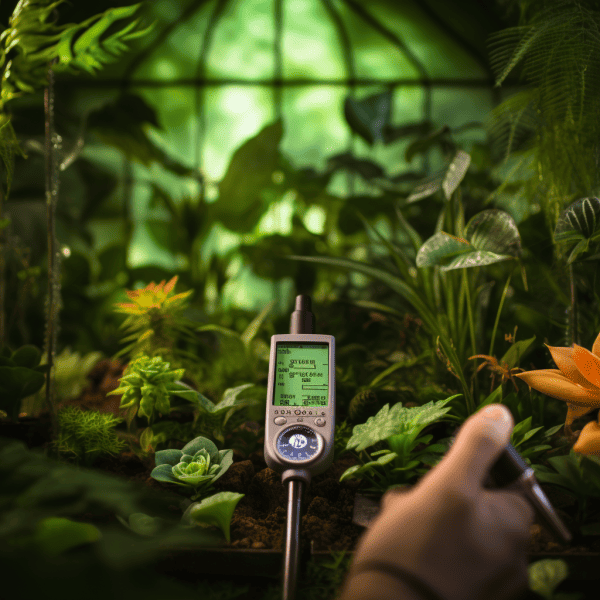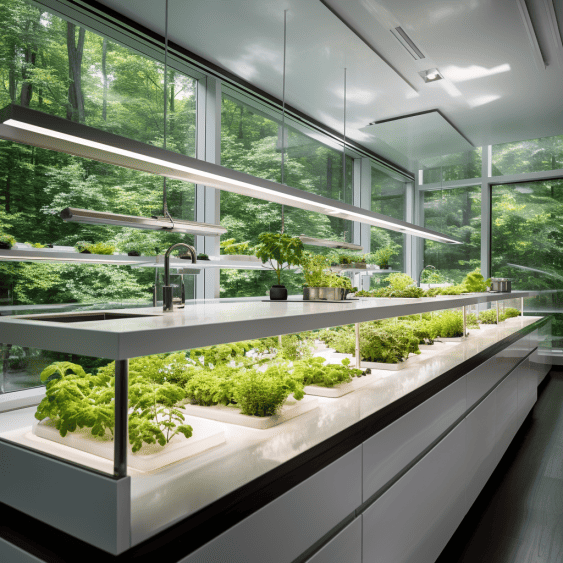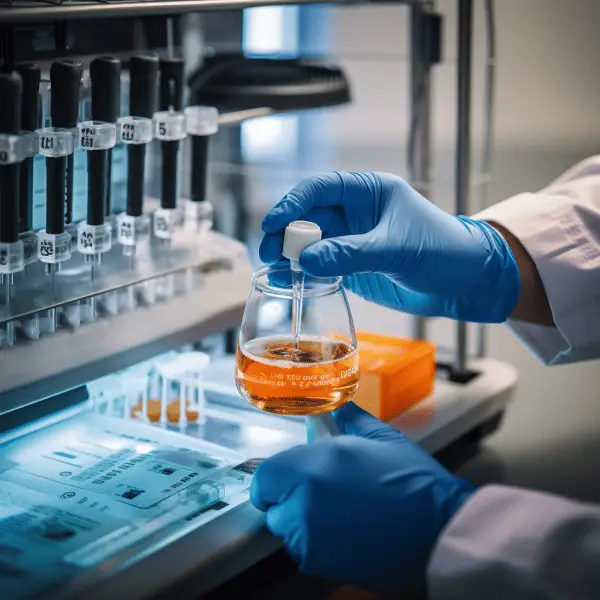How and why to use a pH tester? As a hydroponic gardener, I learned the hard way just how crucial monitoring pH really is. After losing countless plants to nutrient deficiencies, I finally bought a decent pH meter and saw amazing results. Proper pH balance is absolutely essential for healthy plants and big yields.
Let me take you on my hydroponic pH journey. When I first set up my hydroponic operation, I figured pH wasn’t a big deal. The plants grew quickly at first as I added the nutrient solution. But within weeks, the leaves started yellowing and plants stalled out. I tried just adding more nutrients, but it only seemed to make things worse.
After way too many failed crops, I finally got a digital hydroponic tool as pH tester and started monitoring the water daily. Turns out the pH was crashing far too low, preventing my plants from absorbing nutrients properly. By manually adjusting it to the optimal range, the plants greened up fast. I finally had the control I needed!
If you want to be a successful hydroponic or soil grower, get yourself a reliable pH meter! Let me explain why this is the first tool you need and how to use it for thriving plants. Stick with me and I’ll help you unlock the secrets of pH power!
KEY TAKEAWAY
How and why to use a pH tester
Understanding how and why to use a pH tester (1) empowers you to accurately analyze and make informed decisions based on acidity levels in various fields, from scientific research to gardening and beyond.
Understanding the Purpose of a pH Tester
Whether you’re growing plants in soil, hydroponics, or aquaponics, monitoring pH is critical for healthy crops and aquatic life. This is where a pH tester comes in – it measures the acidity or alkalinity of water and growing mediums. But why is managing pH so crucial?
pH affects the availability of key nutrients that plants and fish need to thrive. Each species has an optimal pH range for maximum nutrient absorption. If pH drifts too high or low, it can cause deficiencies, stunted growth, and death.
A pH meter allows careful monitoring and adjustment to maintain the “sweet spot”. For hydroponic tomatoes, the target is pH 5.5-6.5. Tilapia prefer pH 7-8 in aquaponic systems. Without a way to measure pH, you’re growing blind and problems arise.
A quality pH tester takes the guesswork out of nutrient management. The instant, accurate readings allow for precise adjustments using pH Up and Down solutions. This control over pH leads to thriving plants and animals!
Types and Components of pH Meters

There are a few common types of pH testers and meters:
- Litmus paper – disposable strips that crudely estimate pH range
- Tester pens – portable pen-shaped meters with digital readout
- Benchtop meters – more advanced and accurate, for lab use
No matter the type, all pH testers contain a measurement probe, display, and calibration tools (2). The probe contains an electrode that generates an electrical signal. This signal is converted into a numeric pH value. Probes must stay hydrated and calibrate frequently.
For home growing, tester pens offer convenience and accuracy on a budget. They easily measure pH in water or growing media. More advanced hobbyists may invest in a quality benchtop meter for lab-grade precision in monitoring their greenhouse or fish farm.
Step-by-Step Guide on How to Use a pH Meter

Using a pH meter is straightforward once you get the hang of it. Here’s an overview of the process:
- Calibrate the meter regularly per instructions, usually weekly. This ensures accuracy.
- Rinse probe tip thoroughly with clean water between tests.
- Submerge the probe tip in the water/solution being tested.
- Gently stir or swirl the probe to release any bubbles on the sensor.
- Wait for the reading on the meter’s digital display to stabilize, usually about 30 seconds.
- Record the pH value that remains steady on the display.
- Rinse, clean if needed, and store probe properly between uses.
Following the manufacturer’s instructions for your particular meter model is important for precise results and longevity. With practice, testing pH will become second nature!
Maintaining and Caring for the pH Meter Probe
The probe is the heart of any pH meter, so proper maintenance and handling ensures ongoing accuracy:
- Always keep the probe tip wet – dryness damages electrodes. Store long-term in conductive storage solution.
- Avoid touching the glass bulb – skin oils interfere. Only handle the upper body.
- Rinse gently after each use – don’t wipe or scrub the sensitive bulb.
- Soak in mild acid or alkaline solution to clean mineral buildup.
- Replace aging probe yearly or if readings seem inaccurate even after calibration.
With care, your pH probe will deliver reliable readings for years of gardening success!
Importance of Regular Calibration for Accurate Readings
I can’t stress enough how crucial frequent calibration is for ensuring your pH meter provides precise, reliable data. But what exactly does calibrating entail? And why is it so essential? Here’s a deeper look:
Calibration involves taking the meter probe through one or multiple preset pH buffer solutions to “reset” the electrode response curve back to the standard. Most meters need a 2 or 3 point calibration.
Over time and repeated use, the probe’s ability to convert the electrical signal into an exact pH number can drift from the true value. Frequent calibration zeroes it back in.
Environmental factors like temperature fluctuations and chemical exposure also alter the probe’s response. Regular calibration compensates for these changes.
Without periodic calibration, your pH readings can be up to 0.5 units off. Such inaccuracy is devastating for gardening and aquaculture. Nutrient availability, disease resistance, and growth depend on precise pH control.
My rule of thumb is to calibrate weekly minimum, more often for mission-critical processes. It only takes a few minutes and ensures the data I act on is totally reliable. Don’t skip this crucial step!
Dealing with Crystals Forming on the pH Meter
One annoying issue I’ve experienced using pH meters is the development of crystalline buildup on and around the probe. These crusty deposits interfere with accuracy by insulating the electrodes. Here are tips for prevention and removal:
- Rinse probe gently after each use, and avoid drying the bulb completely. Crystals form as mineral-concentrated moisture evaporates.
- Soak the probe periodically in an acid cleaning solution to dissolve any stubborn buildup. Light scrubbing with a soft brush helps too.
- Avoid touching or wiping the electrode bulb directly. The salt and oil from skin worsens crystal buildup over time.
- Store the probe correctly – upright and immersed in storage solution, secured to avoid banging the fragile bulb.
An ounce of prevention is worth a pound of cure when it comes to pH probe maintenance. With good practices, you can minimize annoying crystal formation for smooth pH measuring.
Exploring the Science Behind pH Measurements
Now that we’ve covered pH meter basics, let’s geek out on the science behind how these devices actually work! Here’s an overview:
The pH meter probe contains a sensitive electrode, typically made of glass, that generates an electrical voltage in response to the hydrogen ion activity in the solution.
When immersed, positively charged hydrogen ions in the sample interact with the glass surface. This creates a voltage difference proportional to the hydrogen ion concentration, which indicates the pH.
An electrochemical reaction occurs. The resulting electrical signal gets passed through the meter circuitry, amplified, and converted mathematically into a pH value for output on the digital display.
Regular calibration with buffer solutions ensures the voltage response aligns properly with the pH scale. Rinsing and maintenance keeps the reaction unimpeded for accuracy over time. Pretty neat!
Understanding these fundamental scientific principles will make you a better meter user. While a simple tool, the technology within is quite impressive when you consider it closely!
Tips and Further Reading for pH Meter Users
Here are a few final pointers for new pH meter users looking to master the process:
- Seek models with automatic temperature compensation for easier operation.
- Change batteries promptly when low – unstable power affects readings.
- Look for replaceable probes – cheaper than buying a whole new meter!
- Note manufacturers’ calibration and maintenance recommendations.
- Store probes correctly – rinsed, moist, secure from bumps.
- Account for variances between different sampling methods.
- Consult manufacturer guides for troubleshooting odd readings.
- Read up on the meaning of readings – how pH affects your process.
- Consider a dual EC (electrical conductivity) and pH meter model.
With practice and attention, a quality pH meter will become your best friend for gardening success!
Frequently Asked Questions
What are some examples of why pH monitoring is important?
Proper pH balance is crucial for many processes beyond just gardening and aquaculture. Here are some examples:
- Swimming pools – Prevents damage to plumbing, equipment, prevents eye redness. Target 7.2-7.6 pH.
- Food and beverages – Impacts fermentation, enzyme activity, flavor, and safety.
- Wastewater management – Affects treatment processes and discharge.
- Laboratory experiments – Biochemistry, cell cultures sensitive to pH changes.
- Medical applications – Blood, saliva, urine pH indicates disorders.
- Skincare – Skin pH balance helps moisture and microbiome.
Careful pH monitoring ensures desired characteristics and prevents issues in countless products and processes we depend on everyday!
Is pH test necessary?
Absolutely – there is no way to reliably manage your system’s pH without testing it directly with a meter. Here’s why it’s so necessary:
- Visual signs of issues often only show once pH is drastically out of range.
- Desired pH differs for each plant/animal species. Must measure to know optimal.
- Fluctuations happen rapidly. Daily monitoring needed to catch changes.
- Imprecise methods like test strips are inaccurate for good control.
- Only meter provides instant, precise numerical pH value.
- Needed to calibrate dosing systems and make additive adjustments.
Don’t waste time and money guessing. A quality pH meter provides the control and peace of mind!
What is the advantage of using a pH meter rather than an indicator?
pH meters give instant, precise numerical readings and the ability to continually monitor. Indicators like litmus paper only show an approximate color-coded range.
Benefits of a meter:
- Pinpoint the exact pH value rapidly
- Easily record and track pH over time
- Detect minor fluctuations missed by indicators
- Electronic reliability versus subjective color interpretation
- Portability to test multiple systems easily
For the control and accuracy needed in most applications, a good pH meter is essential!
Conclusion
The bottom line is that a quality pH tester is absolutely essential kit for any gardener. Understanding optimal pH ranges for your plants, and manually adjusting levels as needed, gives you ultimate control over plant health and yields.
I hope sharing my lessons learned about the importance of monitoring pH prevents you from losing valuable crops like I did! Let’s keep the conversation growing about mastering pH together. Share your own stories and tips in the comments!
And please pass this guide along to help spread the word about pH power. The time and money a meter costs is miniscule compared to the benefits. Let’s get growing! Grab that pH pen and start optimizing your garden’s potential.
References
- https://hudsonrobotics.com/how-to-use-ph-meter/
- https://www.omega.com/en-us/resources/ph-meter#:~:text=A%20pH%20measurement%20system%20consists,pH%20of%20the%20measured%20solution.
Related Articles
Was this helpful?

Crystal Erickson is an agriculture enthusiast and writer with a passion for sustainable farming practices and community development. Growing up on a family farm in rural Iowa, Crystal developed a love for the land and a deep appreciation for the hard work and dedication required to make a farm successful.
After completing a degree in Agriculture and Environmental Science from Iowa State University, Crystal began her career as an agricultural journalist, covering stories and issues related to modern farming practices, crop management, and livestock production. She quickly established herself as a respected voice in the industry, known for her insightful reporting and thoughtful analysis.
Over the years, Crystal has written for a variety of publications, including Farm Journal, Successful Farming, and Modern Farmer, as well as contributing to several academic journals focused on sustainable agriculture and community development. Her work has been recognized with numerous awards, including the Iowa Farm Bureau’s Young Farmer Achievement Award and the National Association of Farm Broadcasting’s Farm Broadcaster of the Year.


